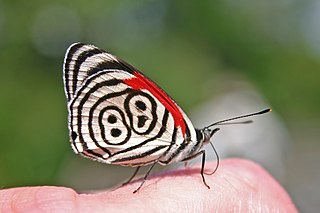Related Research Articles
In Greek mythology, Ceryx was a son of Hermes and either Pandrosus or Agraulus. He was, like his father, a messenger. But the kêryx career began as a humble cook for the tribe, a skill Hermes demonstrates in his cooked meat offerings on the Twelve Gods Altar set in place 522BC by Peisistratos III in Athens. The Homeric Hymn to Hermes 128 recalls the young god cutting out and laying up twelve steaks on a flat rock or platamoni," the 12 Gods altar.
Stein's rat, also known as the small spiny rat, is a species of rodent in the family Muridae. It is found in West Papua, Indonesia and Papua New Guinea.

The white-striped dorcopsis or greater forest wallaby is a species of marsupial in the family Macropodidae. It is found in the northern part of West Papua, Indonesia and Papua New Guinea. It is a common species in suitable tropical forest habitat and the IUCN lists its conservation status as being of "Least concern".

Pseudagrion hageni is a species of damselfly in the family Coenagrionidae. Common names include painted sprite and Hagen's sprite. It is found from South Africa to Kenya, Uganda, the Democratic Republic of the Congo and Angola. Its natural habitats are shaded streams in subtropical or tropical forest, thicket and bush.

Ceryx is a genus of moths in the family Erebidae. It was described by Hans Daniel Johan Wallengren in 1863.

Atrophaneura priapus, the Priapus batwing or white-head batwing, is a swallowtail butterfly found in Burma, Malaysia, Sumatra, and Java. The subspecies A. p. hageni was named to honour Hermann August Hagen. It may be a full species.

Diaethria is a brush-footed butterfly genus found in the Neotropical realm, ranging from Mexico to Paraguay.

Trimeresurus hageni, commonly known as the Hagen's pit viper, is a species of pit viper, a venomous snake in the subfamily Crotalinae of the family Viperidae. The species is endemic to Southeast Asia. There are no subspecies which are currently recognized as being valid.
Similodonta is an extinct genus of early bivalve in the extinct family Praenuculidae. The genus is one of eleven genera in the subfamily Praenuculinae. Similodonta is known from Middle Ordovician through Middle Silurian fossils found in Europe and North America. The genus currently contains eight accepted species, Similodonta ceryx, Similodonta collina, Similodonta djupvikensis, Similodonta magna, Similodonta recurva, Similodonta spjeldnaesi, Similodonta wahli and the type species Similodonta similis.
Ceryx aethalodes is a moth of the subfamily Arctiinae. It was described by Wileman and West in 1928. It is found on the Philippines (Luzon).
Ceryx affinis is a moth of the subfamily Arctiinae. It was described by Rothschild in 1910. It is found in New Guinea.
Ceryx basilewskyi is a moth of the family Erebidae. It was described by Sergius G. Kiriakoff in 1955. It is found in Burundi.
Ceryx bernhardi is a moth of the subfamily Arctiinae. It was described by Seitz.
Ceryx calcuni is a moth of the subfamily Arctiinae. It was described by Obraztsov in 1957. It is found on Java.
Ceryx carpentieri is a moth of the subfamily Arctiinae. It was described by Abel Dufrane in 1936. It is found in the Democratic Republic of the Congo.
Ceryx diptera is a moth of the subfamily Arctiinae. It was described by Johan Christian Fabricius in 1775. It is found in southern India and Sri Lanka. In male, the body is black. Frons, collar and tegulae are yellow. Forewings with a sub-basal, two medial, one sub-apical and two sub-marginal hyaline (glass-like) spots. Hindwings with a sub-basal joined to a sub-marginal spot. Tarsi black. Female is similar to male, but differ with the abdomen dilated and with a tuft of ochreous hairs.
Ceryx helodiaphana is a moth of the subfamily Arctiinae. It was described by Roepke in 1937. It is found on Java.
Ceryx keiensis is a moth of the subfamily Arctiinae. It was described by Rothschild in 1910. It is found on the Key Islands.
Ceryx lamottei is a moth of the subfamily Arctiinae. It was described by Sergius G. Kiriakoff in 1963. It was described from Nimba.
Ceryx salutator is a moth of the subfamily Arctiinae. It was described by Sergius G. Kiriakoff in 1965. It is found in the Democratic Republic of the Congo.
References
- ↑ Beccaloni, G.; Scoble, M.; Kitching, I.; Simonsen, T.; Robinson, G.; Pitkin, B.; Hine, A.; Lyal, C., eds. (2003). "Ceryx hageni". The Global Lepidoptera Names Index . Natural History Museum . Retrieved April 28, 2018.
| This Ceryx-related article is a stub. You can help Wikipedia by expanding it. |